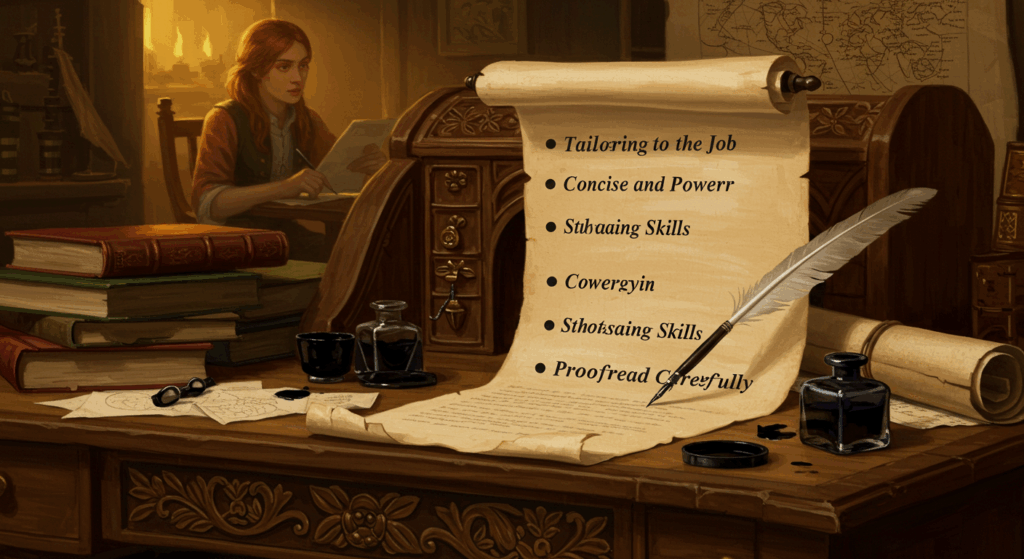Look, I get it. The phrase “write a cover letter” hits the brain like a software update you keep snoozing. Feels optional. Kinda mysterious. Possibly fake? But a cover letter is basically your hype track for a job—your chance to speak like a human, not a spreadsheet, and explain why you’re the person for this role. If your resume is the playlist, the cover letter is the voice note you send before the party saying, “Here’s the vibe. Here’s why it fits.”
And yes, it still matters for job applications. Not always mandatory, but huge when you want to stand out (ngl, the bar isn’t that high because so many people skip it or write the same boring template). Today, we’re going to keep it casual and practical. We’ll talk about the importance of cover letters, what they really are, what to include, what to avoid, how to tailor them, plus real examples you can riff off for your own situation. Grab water. Or iced coffee. Let’s do this.
So… what is a cover letter for a job, actually?
A cover letter is a short (think: 250–450 words) note that rides along with your resume during job applications. The goal is to turmn your experiences into a story that connects you to that job at this company. It’s not a full memoir; it’s more like a trailer—show the highlights, tease the plot, let them want the full movie (aka the interview).
What a cover letter is not
- It’s not a recap of your entire resume line-by-line. That’s just… boring.
- It’s not a creative writing contest. You don’t need metaphors about climbing mountains unless you actually climbed a mountain for this role. And even then—briefly please.
- It’s not a wall of text. Hiring managers skim, fast. Keep it clean, scannable, and specific.
Why it still matters in job applications (the real importance)
- Context: Your resume says what you did. Your cover letter explains why it matters here. Connect your skills to the company’s goals.
- Voice: It’s literally the only place you sound like a person. Humanness > buzzwords.
- Fit: If you’re changing careers, re-entering the workforce, or applying to a stretch role, your cover letter is your best “let me explain” moment.
- Signal: Many candidates don’t include one. When you do, you look thoughtful. That’s an edge.
The anatomy of a great cover letter (simple format that actually works)
You don’t need to reinvent the format, I promise. Use this straightforward flow:
- Header
Your name, email, phone, LinkedIn/portfolio, city (optional). Keep it tidy. - Greeting
“Hi [Name],” is perfect. If you don’t have a name, “Hi Hiring Team,” beats “To Whom It May Concern” (that phrase is a fossil). - Hook (1–2 sentences)
Show you’ve done your homework and state what role you’re applying for. One line of common ground or a quick result you’ve achieved. - The Bridge (3–5 sentences)
Pick 2–3 relevant wins. Quantify if you can. Tie them directly to the job duties. Use the company’s language from the posting. - The Close (2–3 sentences)
Reaffirm your fit, share enthusiasm (keep it real, not “I’m super duper passionate!!!”), and suggest next steps. - Sign-off
“Best,” “Thanks,” or “Warmly,” + your name. Add links again if you like.
Quick format checklist (save this)
- 1 page max, but aim for ~300–400 words.
- 11–12 pt font, easy-to-read (Inter, Calibri, Arial, Georgia—whatever is clean).
- Keep margins normal (around 1 inch). No need for creative chaos here.
- PDF or the format they ask for. If it’s an online field, paste with clean line breaks.
The secret sauce: tailoring. (Yes, you need to customize… but fast.)
Tailoring your cover letter doesn’t have to mean rewriting your soul every time. Use a base template, then tweak three things:
- Name and role
“Hi Alex,” “I’m excited about the Product Designer role at LoomSpark.”
(No “Dear Sir/Madam.” We left that in 2012 with Dubsmash.) - One proof you actually know them
A sentence on their product, mission, recent launch, or the customer they serve. Mention a feature, initiative, or goal. - Two relevant wins
Swap in 2–3 bullets or sentences that mirror the role’s must-haves.
If you’re doing lots of job applications, this tiny tailoring makes your letter feel fresh each time without burning your brain cells.
Writing tips that make your letter feel human (and hireable)
- Talk to one human. Picture a person. Write like a thoughtful coworker, not a Wikipedia entry.
- Use verbs, not fluff. “Led,” “shipped,” “grew,” “designed,” “launched,” “mentored,” “reduced,” “saved.”
- Quantify when possible: “cut onboarding time by 32%,” “boosted retention 14%,” “closed 20+ enterprise deals.”
- Mirror their language. If they say “customers,” don’t say “users.” If they say “pipelines,” use “pipelines,” not “systems.”
- Short paragraphs. Think phone screen. White space is kindness.
- No clichés. “Team player,” “hard worker,” “results-driven” — everyone writes that. Prove it instead with a sentence about a time you did the thing.
- Show a tiny bit of you. Not your diary; just a pinch of voice. One “you know” is charming; ten is chaos.
Common mistakes (and how to fix them)
- Copy-paste with wrong company name. Oof. Triple check. This is the “texting the wrong person” of job applications.
- Too long. If you can’t skim it in 20–30 seconds, it’s too dense.
- All about you, not them. It’s your letter but their needs. Keep tying back to the role.
- Vague claims. “I’m a strong communicator.” Cool. Show me: “I ran weekly stakeholder updates for 4 squads, which cut last-minute scope changes by 50%.”
- No call to action. Close with a confident “Would love to share more on a call,” not just vibes.
How to pull wins out of your experience (even if you feel… meh)
Not everyone has wild numbers. That’s fine. Use these lenses:
- Before → After: What changed because you showed up?
- Scale: How many people? How big was the budget? How many tickets closed?
- Speed/Quality: Faster? Fewer bugs? Better CSAT? Higher NPS?
- Ownership: Did you bwuild a process, document something, train someone, propose an idea?
Even small shifts matter: “Documented onboarding steps and reduced new-hire ramp from 6 to 4 weeks.” That’s value.
Keywords to weave in (without sounding robotic)
If you’re applying online, there’s often an ATS (applicant tracking system). Don’t write for a robot, but do include relevant terms from the posting—tools, frameworks, responsibilities, certifications. Sprinkle them naturally, like salt. Not like you dropped the whole shaker.
Real cover letter examples you can copy-paste and tweak
Below are several quick examples for different situations. Edit generously. Make them yours.
1st Example: New grad / early career
Subject: Application for Marketing Coordinator – [Company]
Hi [Hiring Manager Name],
I’m excited to apply for the Marketing Coordinator role at [Company]. I’ve followed your launch of [Product/Feature] and love how you’re turning complex workflows into something people actually enjoy using—huge.
At [University], I led a student team that grew our newsletter from 800 to 3,100 subscribers in one semester by testing subject lines, building a weekly “What to Watch” content series, and collaborating with clubs to cross-promote. I also ran our TikTok for 5 months, where 8 short videos cleared 10k views and 2 hit 50k+. That experience taught me about fast iteration, creative hooks, and reading analytics without overthinking every single metric (learning to stop doom-scrolling dashboards is a skill, trust me).
I’m eager to bring that mix of content creation, lightweight design, and scrappy experimentation to your team. I’d love to help you grow awareness for [specific product or initiative], and I’m happy to share a few campaign ideas on a quick call.
Thanks for your time,
[Name]
[LinkedIn] • [Portfolio] • [Email] • [Phone]
2nd Example: Career switch (retail → customer success)
Hi [Hiring Team],
I’m applying for the Customer Success Associate role at [Company]. After three years leading the top-performing team at [Retail Brand], I’m ready to bring my people-first problem solving to SaaS.
In retail, I coached a 10-person crew, handled 100+ customer interactions a day during holidays, and built simple “cheat sheets” so new hires could handle edge cases. Our store’s CSAT moved from 4.1 to 4.7 in one quarter, and we cut returns by 18% by clarifying expectations at purchase. I love solving the root problem, not just the surface complaint.
I’ve been teaching myself [Your Product or Similar Tool], and I’m comfortable with CRM basics (HubSpot), docs (Notion/Google), and speaking to different customer types. I’d be excited to help onboard new accounts and keep renewals high—especially for [customer segment].
Would love to share more. Thanks for considering,
[Name]
[LinkedIn] • [Email]
3rd Example: Technical role (software engineer)
Hi [Manager Name],
I’m a full-stack developer (TypeScript/React/Node) interested in the Software Engineer role at [Company]. Your recent post about reducing cold-start latency for serverless functions was catnip to me—great write-up.
At [Current/Last Company], I led a project to migrate a legacy jQuery dashboard to React, cutting bundle size by 41% and page load by ~1.2s. I also introduced a GraphQL layer that cut API roundtrips by 30% for our reporting views. On the backend, I’ve shipped Node services with PostgreSQL, added observability (OpenTelemetry + logs/traces), and contributed to a small internal component library.
I’d love to help [Company] streamline the [feature/team area], especially around performance and developer experience. If useful, I can share a quick loom of a perf profiling workflow I’ve been using.
Thanks for your time,
[Name]
[GitHub] • [LinkedIn] • [Email]
4th Example: Design role (UX/Product Designer)
Hi [Hiring Team],
I’m applying for the Product Designer role at [Company]. I’m drawn to your mission of making [thing] easier for [audience]. The new [feature] is such a clean solution to a messy problem.
In my last role at [Company], I redesigned the onboarding flow for a B2B app that had a 62% drop-off on step two (yikes). After user interviews and 3 rounds of prototypes, we shipped a two-step flow with progressive disclosure. Activation rose 19% and support tickets dropped 27% in 60 days. I partner closely with PM and Eng, and I love documenting decisions to keep teams aligned.
I’m happy to walk you through before/after examples and Figma files. Thanks for considering!
Warmly,
[Name]
[Portfolio] • [Email]
5th Example: Operations / Admin
Hi [Hiring Manager],
I’m excited about the Operations Coordinator role at [Company]. I love building calm, repeatable systems that help humans do their best work (and stop living in spreadsheet chaos).
At [Company], I created a centralized intake form and triage flow for vendor requests, cutting response times from 5 days to 36 hours. I also standardized onboarding checklists so new hires had what they needed on day one (laptops, permissions, contacts), which cut first-week ticket volume by 45%.
I’m eager to bring that structure and empathy to your team. Thanks for your time!
Best,
[Name]
[LinkedIn] • [Email]
How to tailor quickly from these examples
When you reuse an example like the ones above for your job applications, swap in:
- The company’s name, product, or a relevant mission line.
- Two wins that mirror their must-haves (pull from the job posting).
- One hint you know their world (tool, customer type, recent project).
This keeps your voice consistent, while aligning to the role without spending 90 minutes per letter. Work smarter, not scorched-earth.
FAQ (because your brain is asking these in the background)
Do I always need a cover letter?
Not always required, but if there’s a text box labeled “optional,” that’s not optional. It’s a chance to show you’re thoughtful. In competitive roles, a good letter can be the difference.
How long should it be?
Around 300–400 words is a sweet spot. Enough to show substance. Not enough to make the recruiter’s eyes dry.
Should I mention salary, visa, or relocation?
Not in the cover leter unless the posting specifically asks. Use the application fields for those or discuss later.
What if I have no numbers?
Use outcomes: faster processes, happier customers, fewer escalations, smoother onboarding, cleaner docs. Add scale (“supported a team of 12,” “served 200+ customers/month”). Not everything needs to be a percentage.
Can I be funny?
Lightly. A wink, not a stand-up set. The metric is “Would this make a tired hiring manager smile once?” If yes, you’re good.
Keywords and ATS without losing your soul
A lot of job applications run through software that scans for keywords. Your cover letter doesn’t need to be stuffed, but do reflect the language of the posting. If they need “Salesforce,” “SQL,” or “Figma,” say the thing, assuming it’s true. The trick is to integrate these naturally into your actual accomplishments so it doesn’t read like a checklist taped to a paragraph.
Mini template you can personalize in 5 minutes
Use this as your base. Replace the bracketed parts and tweak the middle.
Subject: Application for [Role] – [Your Name]
Hi [Hiring Manager Name or Team],
I’m excited to apply for the [Role] at [Company]. I’ve been following [product/mission/initiative], and I admire how you [short, specific reason you like them].
In my recent work at [Company], I [achievement #1 with a result]. I also [achievement #2 with tool/skill] that led to [result]. Because the [Role] calls for [2–3 responsibilities from the job posting], I believe my experience with [skills/tools] would help [Company] [impact you want to drive].
I’d love to share a few ideas and learn more about what success looks like for this role. Thanks for your time.
Best,
[Your Name]
[LinkedIn] • [Portfolio/GitHub] • [Email] • [Phone]
How to show importance without saying “I’m passionate”
Passion is great, but overused. Show importance by connecting to outcomes they care about:
- “I’d like to help reduce onboarding time so customers get value in week one.”
- “My focus is on clean handoffs between design and engineering so iteration is fast.”
- “I care about proactive support so renewal conversations are chill instead of stressful.”
Those are the kinds of sentences that make hiring teams nod.
If you’re a career switcher, do this
- Translate your wins. Retail = customer success. Teaching = enablement or training. Hospitality = ops and logistics.
- Bridge sentence: “While my title has been [X], the core of my work—[skill cluster like communication, process, training]—maps closely to [target role].”
- Certs and projects: Name two pain points you’ve already tackled via side projects or coursework. Tiny projects are fair game if they’re relevant.
Tone: friendly, confident, not thirsty
You’re not begging for a job; you’re offering help. There’s a difference. The best letters feel like, “I did this kind of work, I noticed you need this kind of help, and I’d like to do it here.” Calm. Capable. Curious.
Quick editing pass (10-minute checklist)
- Read out loud once. Anywhere you trip, simplify.
- Kill filler: actually, very, really, extremely, highly, etc. Bye.
- Swap passive voice: “X was led by me” → “I led X.”
- Numbers: add 1–2 if you’ve got them.
- Company name: correct? Role title: exact? Links: working?
- Save as PDF (unless they ask otherwise).
Extra examples for niche vibes
6th Example: Remote-first culture
Hi [Name],
I’m applying for the Remote Support Specialist role at [Company]. I’ve worked async-first for two years across PST, CET, and IST time zones, so I’m used to crisp documentation, thoughtful updates, and video calls that start on time.
At [Company], I maintained a self-serve help center and recorded 30+ quick loom tutorials that reduced repetitive questions by ~35%. I’m comfortable triaging tickets in Zendesk, creating internal docs in Notion, and partnering with Product on patterns we see. I also like adding small touches of delight—screenshots, emojis, or short GIFs—so support feels friendly, not robotic.
I’d love to keep customers successful at [Company] while championing calm, asynchronous workflows on the team.
Thanks for your consideration,
[Name]
7th Example: Early startup generalist
Hi [Team],
I’m excited about the “wear-many-hats” Operations & Growth role at [Startup]. I’ve run scrappy experiments (cold emails, landing pages, referral loops), and I know when to tighten the process so it stops being chaos.
At [Last Role], I set up the first CRM, built lifecycle emails in Customer.io, and created a simple Airtable → Slack alert that flagged stuck deals. We grew MQL → SQL conversion by ~22% in one quarter. I like moving quickly, writing things down, and then iterating like… a lot.
Would love to help you go from “we’re figuring it out” to “we ship on Tuesdays and sleep at night.”
Cheers,
[Name]
8th Example: Creative field (brief but punchy)
Hi [Name],
I’m applying for the Social Media Producer role at [Company]. My thing is turning scrolls into saves. At [Agency], I storyboarded, shot, and edited 60+ short-form videos; 9 cleared 100k, and one hit 1.2M views with a $0 paid budget (wild).
I’m big on content systems—buckets, scripts, hooks—and small on overthinking. I’d love to help [Company] build repeatable series that your audience anticipates.
Best,
[Name]
[Portfolio]
How your cover letter plays with the rest of your job applications
Think of your job applications as a little ecosystem:
- Resume: Hard data, clean bullets, keywords.
- Cover letter: Narrative glue. Why you, why them, why now.
- Portfolio or GitHub: Proof. The receipts.
- LinkedIn: Context + consistency.
- References: Social validation (no need to list in the letter unless asked).
When these align, you look like a complete package. When they contradict, hiring teams get confused and move on. Keep the story straight.
Quick word on vibe: professional ≠ stiff
You can be warm and still be professional. Think “friendly coworker” more than “Zillow landlord.” Sprinkle in one casual word or two—“hmm,” “you know”—but keep it readable for someone on their fifth coffee of the morning. The importance of clarity beats the importance of sounding like a thesaurus.
Final mini example for senior roles (leadership tone)
Hi [Hiring Manager],
I’m interested in the Head of Lifecycle role at [Company]. You’re at a compelling inflection point—strong product-market fit and room to scale retention and expansion.
At [Current Company], I built a cross-functional lifecycle program across Product, Marketing, and CS that lifted 90-day activation by 17% and net revenue retention from 101% to 112% in two quarters. We did this by aligning on a single activation metric, rebuilding the onboarding sequence, and instrumenting a clean event model so we could actually trust the data.
I enjoy the IC work (mapping journeys, messaging, experimentation) but I’m equally motivated by coaching teams and creating operating rhythms so results repeat. I’d love to explore how lifecycle can power your next stage of growth.
Best,
[Name]
Wrap-up: you got this (seriously)
A cover letter is not a test of your worth. It’s a quick story about why you’re a strong match—told with clarity and a bit of personality. Keep it short, keep it specific, and always tie your wins to what they need. Reuse the examples, tweak for each role, and remember: the goal isn’t perfection, it’s connection.
If you’re about to apply, write your hook now while the posting’s open in your tabs. Two sentences. You’ve got this. Hit send, then treat yourself to a little victory lap (walk, snack, mini Netflix episode—whatever feels right). And hey—if you want fresh eyes on your next draft or a quick punch-up for job applications, drop me a few lines from the role and I’ll help you sharpen it. Go get that interview!Thinking









